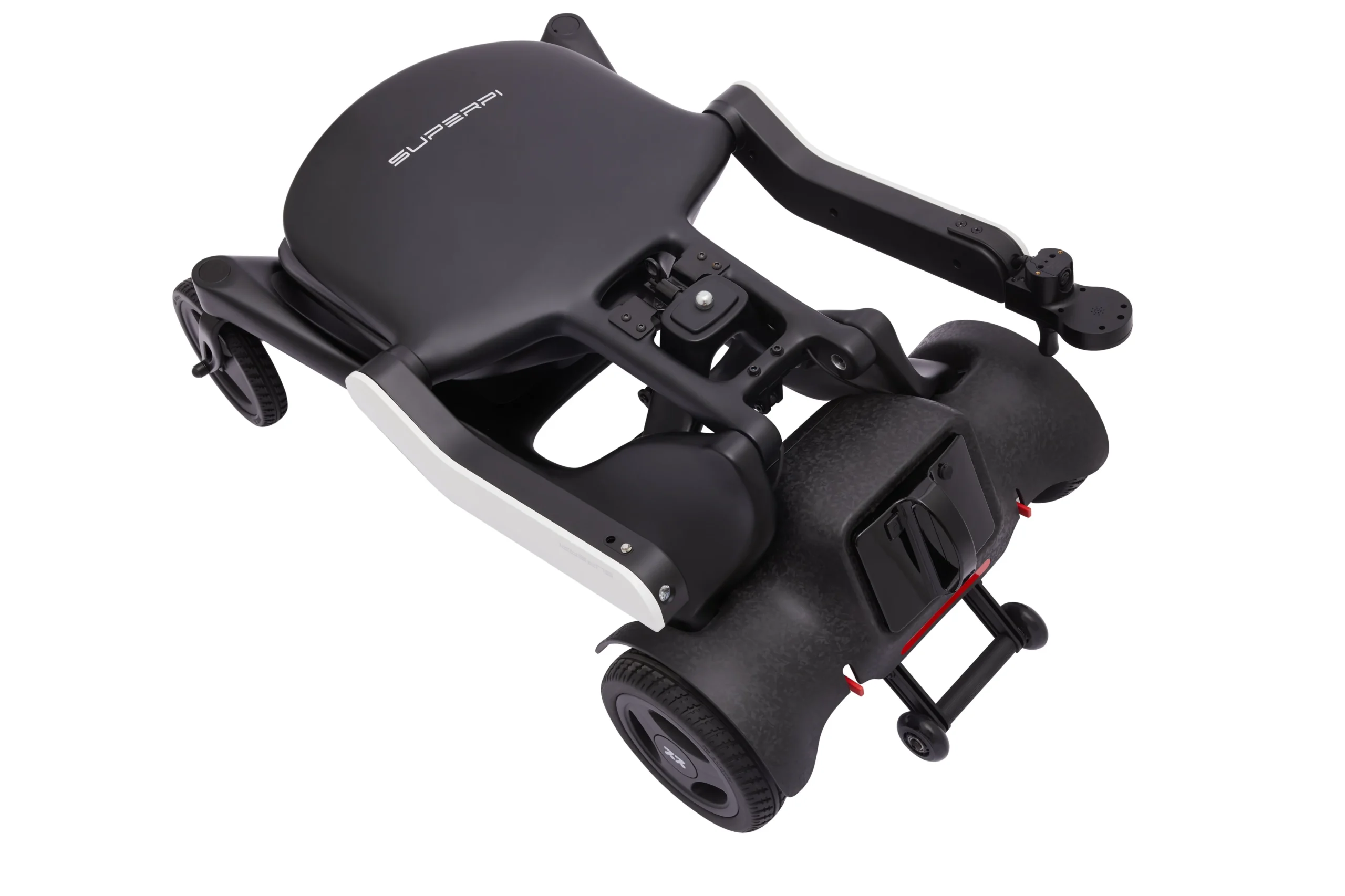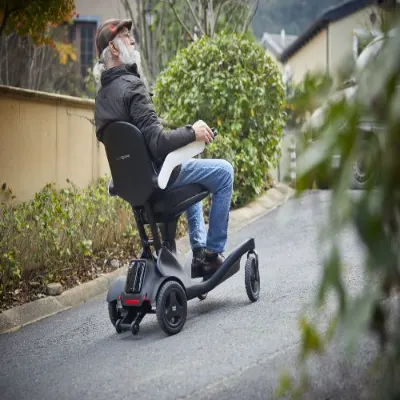
Picking a chair for tight buildings is about tape-measure facts, not glossy photos. Elevators, narrow doors, and crowded lobbies decide what works. This guide focuses on width, folded size, turning inside corridors, calm starts on ramps, and battery planning for short urban loops, with reference specs from a current lightweight platform: dual 250 W brushless motors, quick manual fold with gas-assist lock, IPX4 splash resistance, 21 kg net frame without battery, 120 kg max load, 10° climbing, and two removable lithium packs listing ~22.5 km and up to ~51 km ranges.
What Space Constraints Should You Measure First?
Measure where you live: corridor clear width, elevator door and car width, and the bend that always causes scuffs. Threshold lips change caster behavior more than people think. Note these once; they guide every choice after.
Doorway, Elevator, and Turning Points
Start with your narrowest door, then elevator doorway and interior width. Mark two home turning nodes. A chair near 60 cm wide with a short wheelbase handles older layouts well. A chassis around 960 × 600 × 945 mm, folding to ~960 × 600 × 380 mm, is a practical benchmark for apartments.
Thresholds, Ramps, and Crowd Flow
Log the worst threshold height; compare to stated obstacle height. Watch lobby flow. “Release-to-stop” behavior and steady braking make tight lifts calmer.
Which Dimensions Decide If a Chair Fits?
Width and turning radius do most of the work for indoor maneuverability. Length and folded depth matter for storage closets and car trunks.
What Overall Width and Length Work for Narrow Corridors?
Around 60 cm overall width threads old doors with fewer wall marks. Keep length modest to avoid three-point corrections at every bend.
How Small Should the Turning Radius Be?
If you want a small turning radius wheelchair that feels nimble, look for omnidirectional front casters on swept-wing forks with stable rear drive for clean 360° pivots inside elevators.
How Compact Must It Fold?
Measure closet depth and trunk opening. A rigid fold near 38 cm thick fits more trunks and stands safely when the elevator’s busy. Gas-assist locks speed repeatable folds.
How Much Weight Can You Comfortably Lift or Roll?
Paper weight isn’t carry weight. Split the lift: remove the battery, then lift the frame.
What’s the True Carry Weight With and Without Battery?
A 21 kg frame without battery is manageable for many single-person lifts if grab points sit near the center of mass. Trimming even 1–2 kg helps partners over a month of errands.
How High Is the Lift Into Trunk or Shelf?
Check trunk lip height; ≤70 cm is friendlier. A centered handle reduces swing and keeps shins safe.
Which Fold Mechanism Works Best in Tight Spots?
Extra motions at doors waste time. Count how many actions it takes to fold, lock, and stand the chair.
Does One-Hand or Gas-Assist Folding Save Time?
Gas-assist rigid locks make folds consistent and keep mechanisms tight after hundreds of cycles—useful on trains and in busy lobbies.
Are Handle and Balance Points in the Right Place?
A centered handle beats two low tabs. Upright, no-drama lifts matter more than headline grams.
How Do Motors, Batteries, and Controllers Affect Indoor Maneuvering?
Indoors you want smooth starts, predictable stops, and quiet torque. Range still matters, but controller feel matters more than top speed.
What Speed and Acceleration Settings Feel Safe Indoors?
A ~6 km/h top speed with gentle ramp-up suits elevators and stores. “Stop when you release” should hold cleanly on slopes without rollback.
Which Battery Setup Supports Short Trips and Elevator Hops?
Two removable packs—10 Ah and 20 Ah—map to two range bands (~22.5 km and up to ~51 km). Pick smaller for short urban loops, larger for longer errands and repeated ramps.
How Quiet and Tidy Is the Cable Routing?
Brushless dual motors and a sealed controller bring steady torque and fewer service headaches. Tidy routing avoids snags at door frames.
What Wheel, Tire, and Suspension Choices Help on Hard Floors?
Tiles and lift plates can be slick. You need grip without chatter and a frame that filters micro-bumps.
Which Tire Type Reduces Slip on Tiles?
Solid tires avoid flats; choose tread and compound for your floors. Pair with predictable braking for tight elevators.
How Much Suspension Travel Do You Really Need Indoors?
Independent rear suspension with rubber damping softens curb lips and floor plate gaps, cutting those little “stabilize” brake taps across a week of city use.
What Safety and Compliance Details Matter in Buildings?
Calm control beats raw speed. Predictable braking and visibility make shared spaces easier.
Which Braking Behaviors Keep You Steady on Ramps?
Electromagnetic braking with clear release-to-stop logic keeps you planted on a 10° incline.
What Lights, Horn, and Visibility Aids Help in Crowds?
Low-glare markers, reflective edges, and a modest horn tone help in mirror-lined cars and dim elevators.
How Do Seat, Armrests, and Controls Impact Comfort in Small Spaces?
Short rides still add up. Pressure relief and posture support reduce fatigue in transfer-heavy days.
What Seat Width and Depth Fit You and the Car?
Check ~440 mm seat width and ~445 mm depth against your body and coat. Seat height in the mid-500 mm range eases transfers into common sedans.
Can Armrests Swing Away for Side Transfers?
Swing-away or flip-up armrests help when you park close to elevator rails. Keep joystick clearance in mind.

What Maintenance and Durability Questions Should You Ask?
Tight city use stresses hinges and latches. Plan quick checks so your chair stays quiet and solid.
Which Parts Wear First in Tight-Space Use?
Hinges, latch bushings, and casters see the most cycles. Gas-assist locks lower the wrestle factor, so mechanisms age slower.
How Fast Are Common Repairs and Parts Delivery?
Ask lead times on arm pads, tires, and latch parts. Most city service is simple: tires, alignment, brake checks.
How Do You Prepare for Elevators, Transit, and Stores?
A few small habits make shared spaces smoother and quicker.
What’s the Elevator Etiquette and Positioning?
Let others exit first. Back in if it gives more knee room. Face the door if you need a quick pivot at your floor.
How Do You Handle Crowds and Queue Lines?
Use low-speed mode in busy lobbies. Keep a light strap on the folded package for compressed queues.
Who Is Each Form Factor Best For?
Not every chassis fits every home. Match what you have.
Ultra-Compact Foldable Chairs?
Best for old buildings and micro-elevators where width and folded depth decide everything.
Compact Mid-Range Chairs?
Best for mixed indoor/sidewalk use with occasional trunk storage and routine curb cuts.
Travel-Focused Setups?
Removable packs, a rigid fold, and a protective sleeve make gate checks easier. For a foldable power wheelchair for apartment living that still travels, choose models with removable batteries and a stable standing fold so you can queue, board, and stow without fuss.
Side-By-Side Scorecard to Shortlist Models?
Score width, length, folded depth, turning feel, carry weight, lift height, daily range, braking on ramps, and fold motions. A simple 1–5 table sorts your top three fast.
Buying Checklist Before You Order?
- Measure elevator door and interior width, plus your narrowest home door
- Test a hallway pivot where scuffs usually happen
- Confirm lift height to your trunk lip
- Size the battery for a day’s errands with a 20% buffer
- Try one fold with your usual coat and gloves
- Save a simple comparison note for indoor maneuverability so you can revisit specs later
Introduction to Super Pi Robot
Super Pi Robot focuses on lightweight, travel-ready power chairs built for real buildings. The current P2 platform pairs a quick manual fold with a gas-assisted rigid lock, a compact standing package near 960 × 600 × 380 mm, dual 250 W brushless motors for calm starts, removable 10 Ah or 20 Ah lithium packs for practical range planning, and IPX4 splash resistance for wet sidewalks. Comfort gets real attention: an integrated carbon backrest with a 3D cushion supports posture while independent rear suspension and rubber damping filter bumps at threshold plates. Net result—steady pivots in narrow halls, clean holds on 10° ramps, and a frame that still feels tight after months of daily folds.
FAQ
Q1: What width should you target for small elevators and doors?
A: Around 60 cm overall width with a short wheelbase reduces wall contact and three-point turns.
Q2: How do you choose between two battery sizes?
A: Match to your longest day with a 20% buffer—smaller for short loops, larger for errands across town with ramps.
Q3: What features improve indoor maneuverability most?
A: Compact chassis, omnidirectional front casters with swept-wing support, and predictable rear-wheel drive for tight pivots.
Q4: What braking behavior keeps you steady in buildings?
A: Electromagnetic braking with clear release-to-stop logic that holds on 10° inclines.
Q5: How can you test if a model truly counts as a small turning radius wheelchair at home?
A: Mark a 78–80 cm circle and attempt a clean pivot; minimal corrections and stable posture mean a good tight-space fit.






